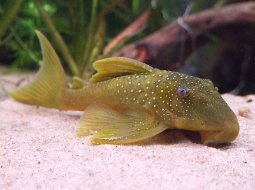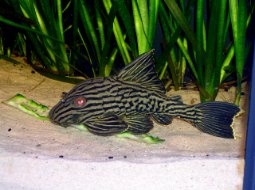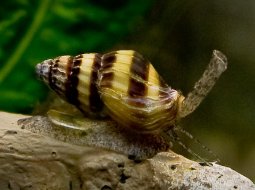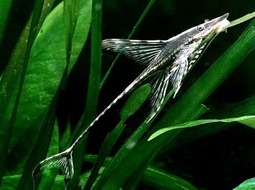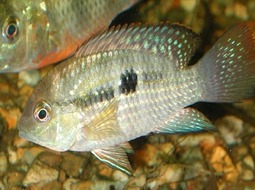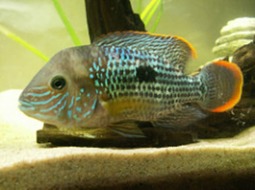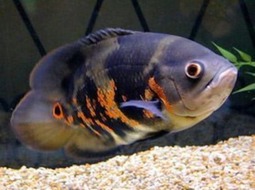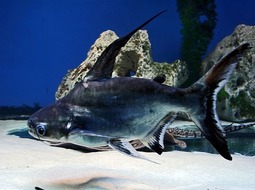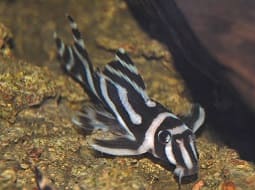
Loading Aqualapp ...
Care and Compatibility of Rio Grande cichlid - Herichthys cyanoguttatus
Introduction
Herichthys cyanoguttatus, also known as Texas Cichlid or Pearl Cichlid, is a cichlid species native to the river basins of southern Texas and northeastern Mexico. These fish inhabit freshwater environments and prefer habitats with sandy substrate and rocks that provide them with hiding places and spawning sites. Their natural distribution ranges from the Nueces River in Texas to the Soto la Marina and Pánuco Rivers in Mexico.
Behavior
The Texas Cichlid is known for its territorial and aggressive behavior, especially during breeding and territory defense. They are intelligent and curious fish that explore their surroundings, interact with other fish, and display interesting behavior patterns. While they can be aggressive towards other fish, they can be kept in community aquariums if suitable tankmates are chosen and sufficient space and hiding spots are provided.
Sexual Dimorphism
Sexual dimorphism in Herichthys cyanoguttatus is subtle. Males tend to be slightly larger and may have longer, more pointed fins compared to females. During breeding season, males may develop more intense colors and courtship patterns to attract females.
Reproduction
The Texas Cichlid is an oviparous species and reproduces through egg-laying. During breeding, males become particularly aggressive and vigorously defend their territory and mate. They build nests on hard substrates and protect the eggs and fry until they are large enough to fend for themselves. Successful breeding requires proper water conditions and a nutritious diet.
Aquarium Conditions
Herichthys cyanoguttatus is a cichlid that prefers a spacious aquarium with rocks, gravel, and hiding spots such as caves and driftwood. They also appreciate dense, sturdy vegetation that provides them with shelter and spawning areas. Maintaining good water quality and an efficient filtration system is important.
Feeding
The Texas Cichlid is an omnivorous fish and feeds on a variety of foods in its natural habitat. In the aquarium, they can be fed a balanced diet that includes specific cichlid commercial foods such as pellets and high-quality flakes. They also enjoy fresh and frozen foods like shrimp, worms, and vegetables. Providing them with a varied diet is important to maintain their health and vibrant coloration.
Complexity
Caring for Herichthys cyanoguttatus can range from moderate to advanced, depending on the aquarist's experience and the size of the aquarium. They are territorial and can be aggressive towards other fish, so it's important to provide them with enough space and territory.
In case you need more help, or if you want to know into any topic related to the Herichthys cyanoguttatus (Rio Grande cichlid) and even any other species you can use the forums to ask what you need.
To do an analysis more detailed about coexistence and behavior of Herichthys cyanoguttatus (Rio Grande cichlid) use the Aquarium simulation tool, if you do this you can test different ways to combine the Rio Grande cichlid with other fishes giving the dimensions and space on you aquarium, on this way you can known the optimal configuration for keep the fishes that you want.
You can also find out the 35 species compatible with the Herichthys cyanoguttatus (Rio Grande cichlid) can live together.
Note: The parameters of the water such as PH and temperature are also used to calculate the compatibility of the species.
Compatible species (35)
Compatible (7 Species)
Compatible without any restriction
Similar Sizes (1 Species)
They can coexist if they are the same size or very similar sizes, it does not work in all cases, there may be exceptions.
With Reservation (12 Species)
Compatible in some cases, it depends on the nature and personality of the fish.
Las especies territoriales por lo general pueden convivir con especies protegidas con coraza, ya que no pueden hacerles daño por su dura piel, lo que si hay que tener en cuenta es tener un acuario con dimensiones favorables para que cada pez pueda delimitar un territorio, ya que la mayoría de peces acorazados son también peces de fondo y les gusta estar buscando lugares donde ocultarse.
These fish know not to eat other fish with an exoskeleton, but you might try to eat it.
Showdown over territory (9 Species)
Fish can live together as long as the space is spacious enough to delimit a territory, otherwise there may be aggressions for competing for the territory.
Considerable size difference (4 Species)
These fish know not to eat other fish with an exoskeleton, but you might try to eat it.
They can coexist while they are similar in size or the size difference is not very abysmal, since as the fish grows it increases the chances of eating its partner that did not grow much.
Compatible if space is enough (2 Species)
They can coexist together if the aquarium they share is large and spacious enough for both species to feel good, as some fish may attack others to feel that they have little space and try to eliminate the competition.
Rio Grande cichlid
Herichthys cyanoguttatus

- Ph: 6.5 - 7.5
- Temperature (c°): 24 - 27
- Measures: 25 cm - 30cm
- Aquarium Capacity:
150 Liters - 40 Gallons - Alimentación: Omnivores
- Colores: Blue, White
- Comportamiento: Active, Semi Aggressive, Territorial
- Habitad: American
- Preferencias del Acuario: Rocks
- Tamaño: Big
- Taxonomía: Cichlids, Fish
- Tipo de Agua: Sweet water
- Velocidad de nado o movimiento: Normal
- Zona de Nado: Aquarium background, Swim in the middle of the aquarium

.jpg)

